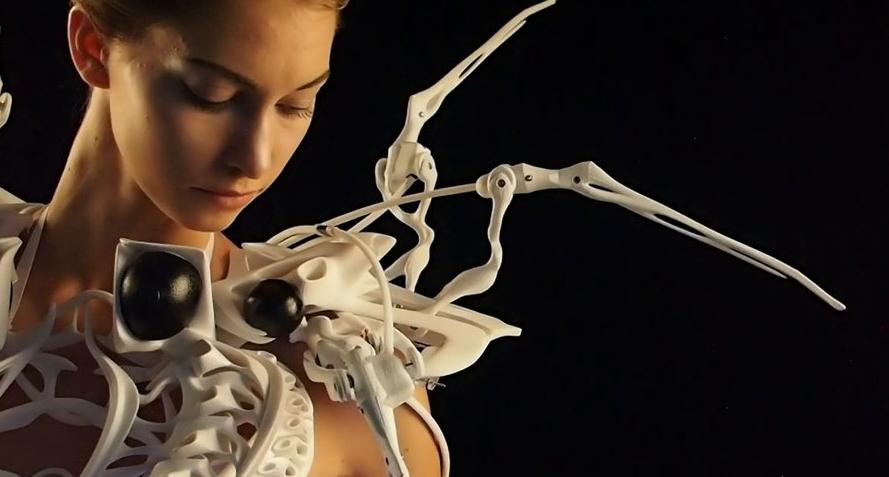When you meet the woman wearing this dress, you won’t need to have a deep understanding of body language to know where you stand in her estimation.
Dutch engineer and designer Anouk Wipprecht is prepared to help you ruin – or perhaps enjoy – a first date with clothing beyond the horrors of standard couture. If you’re putting out an even slightly creepy vibe as you interact with the wearer, the dress will attack you. If you’re smooth like butter, the dress will welcome you forward.
Wipprecht designs ‘wearables’ of a futurist sort, and clothing like her Faraday’s Cage dress literally crackled with electricity.
Her latest creation is so repellant, so repulsive that only the most daring woman would consider putting it on.
The idea is based on how arachnids respond to stimulus, and her “Spider Dress” is specifically programmed to be reactive to what she calls “threatening social behavior” using an array of genuinely disturbing, 3D printed robotic appendages.
Set to premiere at the Consumer Electronics Show in Las Vegas on January 6, the dress is a true horror show.
Wipprecht says her fashion education began at the age of 14, and it led to her focus on divining the “emotional, intellectual and sensual aspects” of couture through “a higher state of connectivity between the body and our clothing.”
The designer says she spent a year in Sweden at the Malmo university where she studied how Arduino-based applications could interact with her smart-fabric concepts. She later served as an assistant to Sabine Seymour in Vienna, Austria, and followed that experience by collaborating with Aduen Darriba on a project called Technosensual.
Hearing the artist describe how the dress reacts? That’s not a pleasant prospect by any means.
“This piece of wearable tech features animatronic mechanical limbs that respond to external stimuli to defend the personal space of the wearer. The dress provides an extension of the wearer’s intuition. It uses proximity sensors, as well as a respiration sensor, to both define and protect the personal space of the wearer. Approach the wearer too aggressively and the mechanical limbs move up to an attack position. Approach the system under calmer circumstance and the dress just might beckon you to come closer with smooth, suggestive gestures,” Wipprecht says.
The dress was 3D printed via selective laser sintering, and it’s driven by 20 embedded proximity sensors. The bio-signals the dress generates are transmitted wirelessly through the Intel Edison platform.
“[The Dress] knows when you are focused or distracted. It knows when your heartbeat or stress level rises, and it records with a camera when your brain activity is highest to provide a sort of mood – or attention map – of your day. This gives an interesting interplay between co-control and education of your own body and mind,” Wipprecht told Vice.com. “If you wear a design that you partly control, and it partly extends your agency through its autonomous actions, you start to question where you end and my system begins.”
The dress took some five months to build with the help of Philip H. Wilck of Studio Palermo.
What do you think of this dress that uses biosensors to gauge the moods of the wearer? Would you wear a dress or a shirt that attacks potential threats nearby? Let us know what you think at the 3D Printed Attack Dress forum thread on 3DPB.com.
Subscribe to Our Email Newsletter
Stay up-to-date on all the latest news from the 3D printing industry and receive information and offers from third party vendors.
You May Also Like
Precision at the Microscale: UK Researchers Advance Medical Devices with BMF’s 3D Printing Tech
University of Nottingham researchers are using Boston Micro Fabrication‘s (BMF) 3D printing technology to develop medical devices that improve compatibility with human tissue. Funded by a UK grant, this project...
3D Printing Webinar and Event Roundup: April 21, 2024
It’s another busy week of webinars and events, starting with Hannover Messe in Germany and continuing with Metalcasting Congress, Chinaplas, TechBlick’s Innovation Festival, and more. Stratasys continues its advanced training...
3D Printing Webinar and Event Roundup: March 17, 2024
It’s another busy week of webinars and events, including SALMED 2024 and AM Forum in Berlin. Stratasys continues its in-person training and is offering two webinars, ASTM is holding a...
3D Printed Micro Antenna is 15% Smaller and 6X Lighter
Horizon Microtechnologies has achieved success in creating a high-frequency D-Band horn antenna through micro 3D printing. However, this achievement did not rely solely on 3D printing; it involved a combination...


































